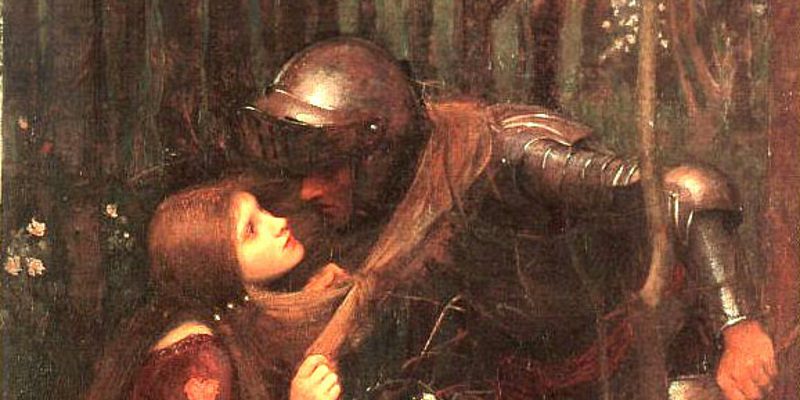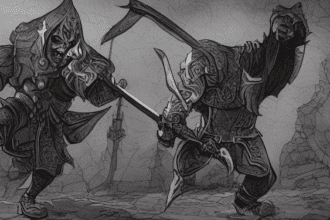The Paladin Class, Part Four

My general sense of the Paladin class is that it really took root in the imaginations of gamers during the eleven years of 2e’s publication (1989 to 2000), but as soon as the 3.0 Paladin came along, its one meaningful addition to the class’s mechanics propagated all but instantly throughout gaming. The thematic shift of 3.x also “bred true,” leaning Paladins away from high and courtly knighthood. But I’m getting ahead of myself…
(Part One, Part Two, Part Three)
D&D 3.0
As you almost certainly know, the third edition of D&D implemented several huge changes, and two of those affect the Paladin more directly than any other class. First off, there are no more ability score prerequisites to enter a class, so you can play a Paladin without a 17 Charisma… though if you have a spare 17+ ability score lying around, Charisma is a very good choice for paladins. Secondly, you can play a paladin without being a human. No other class of 2e was as restricted as the Paladin; the DMG included a pearl-clutching account of how overpowered an elven paladin would be, to make sure that DMs knew how inappropriate that would be. I’m pretty sure no one misses that restriction, but at the same time, the 3.0 and 3.5 Player’s Handbooks try to steer elves away from being paladins by pointing out how elven society clashes with a paladin’s Lawful alignment.
Beyond the lifted restrictions, there are also some solid new class abilities and some changes to what came before:
- Instead of a +2 to all saving throws, paladins add their Charisma bonus to all saving throws. This is mighty nice, especially if you can improve your Charisma further with an eagle’s splendor spell or a magic item. Notably, the cloak slot normally covers both saving throw bonuses (cloak of resistance) and Charisma bonuses (cloak of Charisma, in a stunning display of inventive naming), and the Paladin is the one class that doesn’t find this to be a pain in the ass. It’s less of an overall bonus to saving throws, but a much greater overall benefit.
- The healing output of lay on hands is (paladin level x Charisma bonus). Even this healing pool and the Paladin’s spellcasting aren’t enough to make them suitable primary healers in a party, but they have excellent survivability and make good secondary healers.
- Disease immunity now includes magical diseases such as lycanthropy and mummy rot, which were specifically excluded in previous editions. So much for my dreams of a werebear paladin?
- At second level, they become immune to fear (boo, hiss, immunities) and project resistance to fear to nearby allies. This largely replaces the aura of protection.
- Smite Evil is the new hotness that alters how people have approached paladins since. In 3.0, though, Smite Evil is more “nice to have” than “obviously central class ability,” because you get one use per day and that’s it. Adding your Charisma bonus to the attack roll and your paladin level to damage is nice, but missing or targeting something that you haven’t already checked for Evil alignment both mean your Big Whammy attack is gone. This is going to get substantially beefed up in every revision of D&D’s rules that follows.
- For evidence on how Smite Evil became central to paladins in other games, see World of Warcraft on through Pillars of Eternity. Warcraft II and Warcraft III each give Paladins a magical attack that only works against undead (Exorcism and Holy Light, respectively), but WoW doubles down triples down greatly increases this, such that a paladin can be a DPS class if the player wants. I think this grew out of Smite Evil adjusting the way the broader gaming community thought about paladins. I could, of course, be overlooking other key influences.
- Spellcasting starts at 4th level if you have a Wisdom bonus, or 6th level if you do not, rather than 9th There is now a unique Paladin spell list, rather than using a partial Cleric spell list – this includes spells that do not appear on any other list.
- The paladin can call a special mount at 5th level or anytime thereafter, and its stats scale rather impressively as the paladin advances. If the mount dies in service, the paladin has to wait a year and a day before calling another. Presumably this does not occur if the mount is restored to life. A year and a day is still longer than some whole campaigns I’ve run, but it’s a lot better than ten years!
- The paladin’s code of conduct is largely the same, except that atonement can repair the loss of class abilities for even a deliberately evil act.
The knightly aspects of the class are toned way down in the flavor text. While a holy knight is still a highly applicable interpretation of what’s here, there’s no expectation that paladins of any non-human race would conform to Western European knighthood, and as a result it feels like there’s room for other human cultures as well.
The Paladin does have one “new” restriction: in parallel to the Monk, Paladins who multi-class out of the Paladin class are gone for good, because the Paladin class requires devotion. I’m not really sure why the priesthood shows less zealous devotion than the ranks of the paladins (either imposing the same restriction on Clerics, or allowing paladins to multi-class freely into Cleric), or why an ascetic vow might not reasonably allow free multi-classing between Paladin and Monk, but 3.x apparently believes this rule to be important. As an arbitrary restriction, it has a lot in common with the long-standing rules that the designers tossed out the window as they moved from 2e to 3.0, but it won’t be until 4e that this one gets cut… insofar as we can really say 4e has multi-classing at initial release.
Moving on along…
D&D 3.5
My primary exposure to paladins in 3.x is specifically 3.0, because a game I ran for two years in college had a paladin, but 3.5 was the “current” edition of D&D for longer and more recently, so it’s the one I remember better. The truth is, if you’re just looking at the Player’s Handbooks, they’re very close to identical.
- Smite Evil starts at 1st level rather than 2nd, and the paladin gains an additional use of Smite Evil at 5th level, and every 5 levels thereafter. It makes me glad that later editions introduced a concept of per-encounter or per-short-rest powers.
- Lay on Hands starts at 2nd level rather than 1st. I might just disagree with this change, on the grounds that only Smite Evil can compete with Lay on Hands as the most iconic paladin ability.
- Divine Grace (Charisma bonus to saving throws) works the same way, but it comes in at 2nd level rather than 1st. This is likely an attempt to hinder one-level multi-class dipping, which was a major problem in 3.0 and a still significant problem in 3.5.
- Divine Health (disease immunity) works the same way, but paladins receive it at 3rd rather than 1st Presumably this was done for the same reasons as with Divine Grace.
- Aura of Courage starts at 3rd level rather than 2nd.
- Turn Undead starts at 4th level rather than 3rd, and functions as a cleric of (paladin level -3) rather than (paladin level -2).
- The Paladin spell list is a lot beefier, continuing their position as secondary healers but also giving them several more offensive spells. If you think the campaign might continue through 15th level, make sure you’ve got a 14 or better in Wisdom, because you will kick yourself if you’re missing out on 4th-level Paladin spells (even if the only one you ever cast is holy sword).
- For some reason, remove disease got pushed up to 6th level, from 3rd. Since it scales at the same rate as it did before, this means a 20th-level paladin has one less remove disease per week. I’m not sure why this was important to them, but then disease was never a significant part of our 3.x games.
- The paladin’s mount gains Improved Speed to go with its other abilities as it gains Hit Dice.
- Detect Evil hasn’t changed significantly since… ever, but it’s still a plot-ruiner and I’m going to call it out for its misdeeds.
Mechanically, this is better overall, and keeps the Paladin compelling in the face of the increased potency of other classes in the 3.5 revision. The increased number of Smites per day is the easily the most important thing on the page. Thematically, the change to Smite Evil and to the Paladin spell list shows us a still more aggressive side to the Paladin, backed up by the Gods with something more than top-notch defenses and harsh language.
So About the Blackguard
Since I covered the Anti-Paladin of 1e, I’ll do the same for the Blackguard prestige class of 3.5. (The Blackguard of 3.0 was essentially the same.) The Blackguard is nominally intended to be a valid choice for evil characters of every class, but in reality I can’t see any full spellcasting class dropping their spellcasting advancement to pick up any significant number of Blackguard levels. It is an evil mirror image of the Paladin class, except that it also gains Sneak Attack dice (here mimicking the Backstab damage of the Anti-Paladin).
The most interesting feature of the Blackguard is the special rules for fallen paladins, lending strong mechanical support to the fall to the Dark Side. Because paladins lose all of their class abilities when they fall from grace, they would be much weaker than, say, a blackguard who met the class’s requirements some other way. With these rules, it’s hard to say whether or not they’re weaker, because there are some options that might or might not make a difference.
The awkward thing about framing the Blackguard as a prestige class, though, is that the fall from grace may well be a snap decision in a moment of weakness… but if the player wasn’t actively preparing for that fall with feat and skill point purchases, or if the paladin is lower than 6th level (for the base attack bonus pre-requisite), the character has to keep advancing for one or more additional levels, without the support of the lost paladin abilities, just to qualify. Mechanics allowing a character to respend feats or skill points didn’t come along until very near to the end of 3.5’s run.
Obviously, any DM who feels the confidence to ignore the rules and put the story first won’t have a problem here, but that’s not everyone, and these rules could definitely have been written to guide inexperienced DMs toward best practices. The class kind of needs a few different entry options, because the feat requirements make class entry quite unpleasant for rogues, and most classes think that Hide requirement is awful unless they’ve multi-classed just to qualify. The point I’m trying to make is that qualifying for this prestige class is doable, but you’d think that the slippery slope to damnation could be a little more tempting. The Assassin has it so easy by comparison!
Conclusion
Despite its changes and innovations, the 3.x Paladin cleaves more closely to its 2e progenitor than most of 3.x’s classes. Thanks to the multi-classing structure and feat options (especially the ever-expanding options of 3.x’s many supplements), the mechanics-side case for cutting the Paladin class and just pushing people toward Fighter/Clerics is stronger here than any edition before or since. A little help from the Book of Exalted Deeds (the supplement, not the magic item) is probably the ideal way to bring that to fruition. I would say that 3.x goes so far as to hang a lampshade on this, since a fighter/cleric multi-class is, for a long time, one of the only ways to play a holy warrior backed up with magic and dedicated to a god that is not LG, LN, or NG. Eventually there’s the Crusader in the Tome of Battle and the Knight in the Player’s Handbook II, and any number of prestige classes to help fill the gap, but if you’re the kind of person who would argue for cutting the Paladin class and replacing it with multi-classing, I’m going to bet that adding new classes is not your idea of a good solution. (Odds are that you’re not a big fan of prestige classes, for that matter.)
Next time on History of the Classes: 4e, and what it looks like when the Paladin is all magic, all the time.



